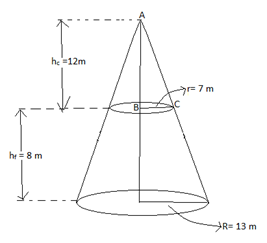A tent consists of a frustum of a cone, surmounted by a cone. If the diameter of the upper and lower circular ends of the frustum be 14 m and 26 m respectively, the height of the frustum be 8 m and the height of the surmounted conical portion be 12 m, find the area of the canvas required to make the tent. (Assume that the radii of the upper circular end of the frustum and the base of the surmounted conical portion are equal.)

Given: Diameter of base of frustum = 26 m
Diameter of top of frustum = 14 m
∴ Radius of base = R = 26/2 = 13 m
∴ Radius of top = r = 14/2 = 7 m
Height of frustum = hf = 8 m
∴ height of cone = hc = 12 m
Formula: Total surface area of frustum = πr2 + πR2 + π(R + r)lf m2
Total surface area of cone = πrlc
Where lf = slant height of frustum & lc = slant height of cone
![]()
![]()
∴ lf = 10 m
Consider right angled ΔABC from figure
AB = hc = 12 m ; BC = r = 7 m ; AC = lc
By pythagoras theorm
AB2 + BC2 = AC2
∴ 122 + 72 = lc2
∴ lc = ![]() 13.892
13.892
Since length cannot be negative lc = 13.892 m
Since for tent we don’t require the upper circle of frustum and the lower circle of frustum hence we should subtract their area as we don’t require canvas for that.
Surface area of upper circle = πr2
Surface area of lower circle = πR2
∴ Surface area of frustum for which canvas is required = πr2 + πR2 + π(R + r)lf - πr2-πR2cm2
= π(R + r)lfm2
= 3.14 × (13 + 7) × 10 m2
= 3.14 × 200 m2
= 628 m2
Surface area of cone = πrlc m2
= 3.14 × 7 × 13.892 m2
= 3.14 × 97.244 m2
= 305.346 m2
∴ Quantity of canvas required = surface area of frustum + surface area of cone
= 628 + 305.346 m2
= 933.346 m2
∴ Quantity of canvas required = 933.346 m2